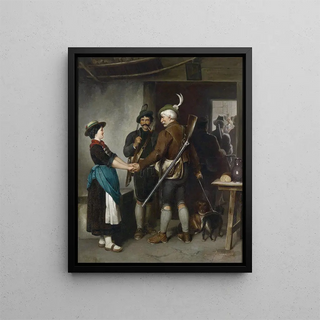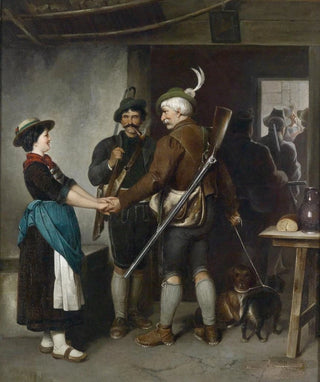Painting L'adieu du chasseur - Franz von Defregger | Art print


View from behind

Frame (optional)
Reproduction L'adieu du chasseur - Franz von Defregger – Engaging introduction
At the heart of 19th-century artistic heritage, "L'adieu du chasseur" by Franz von Defregger stands as an iconic work, capable of capturing the very essence of human emotions and rural traditions. This masterful piece evokes a moment of farewell filled with melancholy and nostalgia, where the hunter, dressed in his traditional costume, bids farewell to his companion. The scene unfolds in an Alpine landscape, where majestic nature serves as the backdrop to this poignant human interaction. The artist succeeds in creating an immersive atmosphere, where every detail contributes to telling a universal story of love and sacrifice.
Style and uniqueness of the work
The uniqueness of "L'adieu du chasseur" lies in Defregger's technical mastery, which combines realism and romanticism with remarkable ease. Warm colors and play of light emphasize the intensity of the emotions on the characters' faces. Delicate expressions and subtle gestures reveal a psychological depth that transcends simple visual storytelling. The artist, influenced by the currents of his time, manages to infuse a narrative dimension into his works, transforming each painting into a lively scene. The meticulous details of costumes and natural elements testify to keen observation, paying homage to Alpine culture while celebrating the beauty of human relationships.
The artist and his influence
Franz von Defregger, born in 1835 in Austria, is often regarded as one of the masters of historical genre and portraiture. His career, marked by a deep attachment to popular traditions and rural life, allowed him to forge a unique artistic identity. Drawing inspiration from everyday life and folk tales, Defregger captured the soul of the people of his time, while incorporating elements of mythology and history. His influence endured long after his death in 1921, inspiring many artists who sought to explore similar themes. By reinterpreting scenes of Alpine life, he not only documented a culture but also paved the way for a deeper understanding of

Matte finish

View from behind

Frame (optional)
Reproduction L'adieu du chasseur - Franz von Defregger – Engaging introduction
At the heart of 19th-century artistic heritage, "L'adieu du chasseur" by Franz von Defregger stands as an iconic work, capable of capturing the very essence of human emotions and rural traditions. This masterful piece evokes a moment of farewell filled with melancholy and nostalgia, where the hunter, dressed in his traditional costume, bids farewell to his companion. The scene unfolds in an Alpine landscape, where majestic nature serves as the backdrop to this poignant human interaction. The artist succeeds in creating an immersive atmosphere, where every detail contributes to telling a universal story of love and sacrifice.
Style and uniqueness of the work
The uniqueness of "L'adieu du chasseur" lies in Defregger's technical mastery, which combines realism and romanticism with remarkable ease. Warm colors and play of light emphasize the intensity of the emotions on the characters' faces. Delicate expressions and subtle gestures reveal a psychological depth that transcends simple visual storytelling. The artist, influenced by the currents of his time, manages to infuse a narrative dimension into his works, transforming each painting into a lively scene. The meticulous details of costumes and natural elements testify to keen observation, paying homage to Alpine culture while celebrating the beauty of human relationships.
The artist and his influence
Franz von Defregger, born in 1835 in Austria, is often regarded as one of the masters of historical genre and portraiture. His career, marked by a deep attachment to popular traditions and rural life, allowed him to forge a unique artistic identity. Drawing inspiration from everyday life and folk tales, Defregger captured the soul of the people of his time, while incorporating elements of mythology and history. His influence endured long after his death in 1921, inspiring many artists who sought to explore similar themes. By reinterpreting scenes of Alpine life, he not only documented a culture but also paved the way for a deeper understanding of
12,34 €






